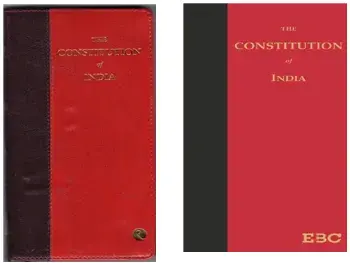By Lucy Rana and Huda Jafri
Introduction
India’s Constitution belongs to its people, but what about the Pocket Constitution that carries it? EBC Pocket Constitution is a familiar sight in courtrooms, classrooms and law chambers alike. But when its very name became the subject matter of a trademark infringement battel, it opened up a compelling discussion on the intersection of IP, legal literature and public domain content.
A recent development has stride a debate in the publication and legal fraternity, Delhi High Court has restrained Rupa Publications Pvt. Ltd.(hereinafter “Defendant”) from manufacturing, selling and publishing its red and black “coat-pocket” edition of the Constitution of India. The injunction order came in response to a suit filed by Eastern Book Company (hereinafter “Plaintiff”), a leading legal publisher, pertaining to its rights in the distinctive trade dress, get-up, and overall presentation of their ‘COAT POCKET edition’ of the Bare Acts of the Constitution of India.
The coat-pocket editions are not only the plaintiffs’ most iconic products but also the flagship of the plaintiffs’ publishing business. The phrase ‘coat pocket’ has been deliberately coined as the size of these bare acts makes them comparatively portable for carrying over the traditional versions.
The dispute has raised an interesting legal question: While the text of the Constitution lies firmly in public domain, can the presentation and design of a published version enjoy proprietary protection under trade dress laws?
Brief Facts of the Case
The Plaintiff having registered trademark under Class 16[1] for their device mark has for over 75 years published a distinctive “Coat Pocket Edition” of the Constitution. The edition is known for its compact size, red and black color combination, gold embossed title, gilt-edged pages and signature layout, all of which together form a recognizable trade dress in legal community.
In November 2024 the Plaintiff discovered that Defendant has released a pocket edition of the Constitution with a nearly identical aesthetic design, including similar color tones, gold embossing and size specifications, selling through similar trade channels as those of the plaintiffs’ including online market places such as Amazon, Flipkart, third-party online channels, as well as retail stores. A side-by-side comparison of the Plaintiff’s coat-pocket edition and Defendant’s impugned coat pocket edition is reproduced as under:

Contentions of Plaintiff
The plaintiff contended that defendant’s intent to pass off its goods as that of the plaintiff is apparent from defendant’s act to:
- Part away with its popular Red-white color scheme logo and replacement of logo
- Change and replace logo.
- Not selling/publishing any other law book/publication but only impugned coat-pocket edition at a cheaper price.
- Imitate the plaintiffs’ layout and presentation style in their own listings on e-commerce platforms,
The table below showcases few of the similarities between the plaintiffs’ coat-pocket editions and the defendant’s impugned coat-pocket editions of the Bare Acts:
| Features | Plaintiff’s Constitution Bare Act | Defendant’s Constitution Bare Act |
| Dimension | 197x96x23 (mm) | 210x117x17 (mm) |
| Color scheme | Black-Red | Blackish Brown-Red |
| Thread color | Black-Red | Blackish-Brown-Red |
| Front Cover | ||
| Title Placement | On top 1/3rd portion | On top 1/3rd portion |
| Font size | 11.5 & 20.8 | 11.5 & 20.8 |
| Font Type | Platino Lino Type | Platino Lino Type |
| Font color | Gold Leafing | Gold Leafing |
| Back | ||
| Logo | Embossed on the bottom | N/A |
| Inside | ||
| Index Style | Divided in parts with the sub-topics capitalized. | Divided in parts with the sub-topics capitalized. |
| Paper Quality | Bible | Similar |
| Font Type | Platino Lino Type | Similar |
Analysis Court’s Order
At the heart of the reasoning of the court was that there was a high chance of confusion by the masses. Hon’ble Justice Manmeet Pritam Singh Arora observed that the two covers were so similar that either of the two could be confused by an ordinary consumer, the visual similarity between the two books was too obvious and important. While granting an interim injunction Court noted that a bare perusal of the plaint and comparison of the plaintiffs’ coat-pocket editions with the defendant’s impugned coat-pocket editions of the Constitution of India, it is prima facie evident that the impugned trade dress/design is deceptively similar to the trade dress adopted by the plaintiffs.
Placing reliance on the case of Colgate Palmolive Company & Another v. Anchor Health and Beauty Care Pvt. Ltd.[2], wherein the court opined that while no party can claim a monopoly over a single color, a distinctive color combination, when consistently used over time, can create customer recognition and goodwill. The Court further held that the substantial reproduction of such combinations in a similar order on packaging can cause confusion and dilute distinctiveness. Trade dress, which includes color combination, layout, container shape, and overall design, enjoys strong protection against imitation, as it identifies the source of goods.
Accordingly, the Hon’ble High Court of Delhi issued following directions:
Restraining the Defendants and its associated from manufacturing, selling, advertising or distributing any pocket edition of the Constitution of India.
- Restraining the Defendants from using red-black trade dress similar to that of the plaintiff’s product.
- Directed the Defendant to remove all unsold copies of the infringing from the market as well as from e-commerce platforms and third-party websites.
Case Referred to Mediation
Following the injunction, a significant procedural development took place in the dispute titled EBC Publishing (P) Ltd. & Anr. v. Rupa Publications India Pvt. Ltd.
The Defendant later filed an application under Order XXXIX Rule 4 CPC seeking vacation of the ex parte injunction. During proceedings, both parties expressed willingness to streamline pleadings and explore settlement.
Based on the parties’ consent, the Court referred the matter to the Delhi High Court Mediation and Conciliation Centre, directing that a Senior Mediator be appointed. The mediation is intended to facilitate a negotiated resolution while the parties continue completing procedural requirements such as admissions and denials of documents.
The case has been listed next for hearing on December, 17 2025, depending on the outcome of mediation.
Conclusion
The Delhi High Court’s injunction, and its subsequent decision to channel the dispute through mediation, demonstrates a nuanced understanding of modern intellectual property challenges. Under trademark law, trade dress encompasses a product’s visual identity, including shape, size, packaging, color schemes, textures, and layout, all contributing to consumer association and goodwill.
In today’s competitive market, distinct packaging has become essential not only for brand differentiation but also for building reputation and consumer trust. Imitation of such distinctive trade dress, particularly with the intention of capitalising on established goodwill, continues to surface in numerous sectors.
The Court’s move to maintain the injunction while promoting mediation reflects a balanced approach: protecting IP rights, preventing marketplace confusion, and encouraging efficient dispute resolution in commercial IP matters.
Sneha Singh, Former Intern at S.S.Rana & Co. has assisted in the research of this article.
[1] THE FOURTH SCHEDULE Classification of goods– Name of the classes,
Class 16: Paper, cardboard and goods made from these materials, not included in other classes; printed matter; bookbinding material; photographs; stationery; adhesives for stationery or household purposes; artists’ materials; paint brushes; typewriters and office requisites (except furniture); instructional and teaching material (except apparatus); plastic materials for packaging (not included in other classes); playing cards; printers’ type; printing blocks
[2] 2003 VIII AD Delhi 228

